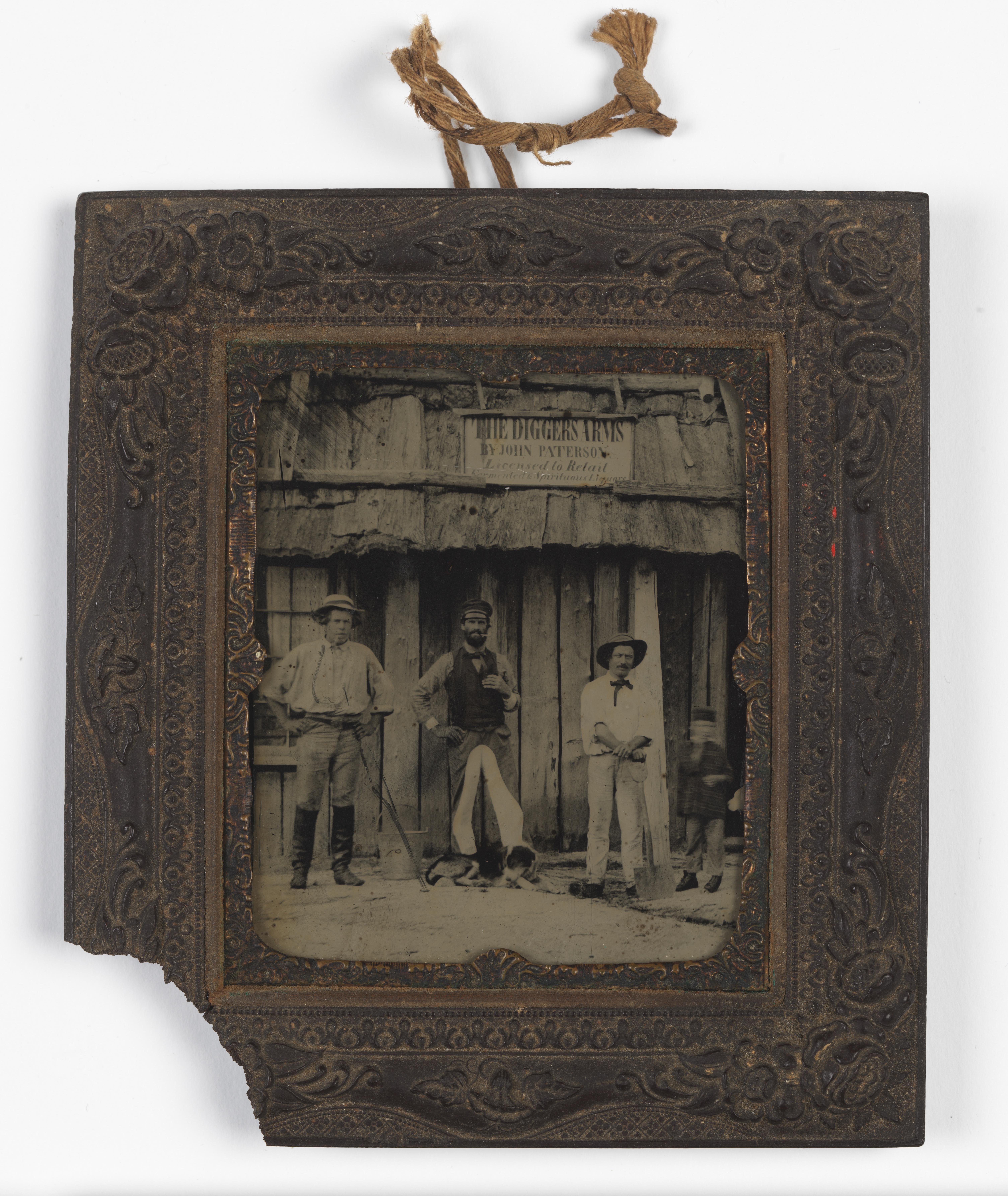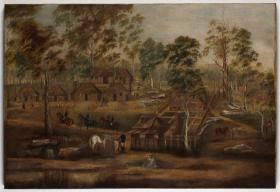Three men and ...
The world of a goldfields publican comes within reach through research to uncover the secrets of an early photograph.
The small, ruby ambrotype photograph offered to the Library was intriguing. It came without notes about its location or date, but it looked like it had been taken on an Australian goldfield.
Pulling together various threads of information, we were able to uncover the secrets of an image that ties together the lives of three very different men and two paintings in the Library’s exhibition Paintings from the Collection.
The rare outdoor ambrotype (a photographic process developed in the 1850s) shows three men and a boy standing in front of a wooden building. A sign on the building reads, ‘The Diggers Arms — by John Paterson — licensed to retail fermented and spirituous liquors’.
To begin, we tried to link the name John Paterson (or Patterson) with a hotel licence for a hotel called the Diggers Arms in the 1850s or 60s. Several ‘Diggers Arms’ appeared in the NSW State Archives Publicans Licenses Index, but none had John Paterson listed as the licensee.
Then on the Trove online newspaper database we found two references in different issues of the Armidale Express and New England General Advertiser to a licence granted to ‘Mr. John Patterson, The Diggers’ Arms, Timbarra’ in 1860 and 1861. Timbarra was a goldfield near the New South Wales town of Tenterfield.
Further online research unearthed a privately published family history and family trees on Ancestry.com mentioning a John Patterson who ran an inn in Timbarra. The family history told of Patterson and his wife Mary’s journey from Scotland in 1849 to settle in the Sydney suburb of Paddington. A baker by trade, John then moved his growing family to country New South Wales, arriving in the newly discovered goldfields of Timbarra in the late 1850s.
We are now confident that the well-dressed man with a neck tie to the right of the photo is the publican John Patterson. He is standing with one of his children, who appears to be wearing a tartan smock and fez-like hat, perhaps confirming the family’s Scottish heritage.
According to the newspaper clippings, Patterson’s publican’s licence was granted by George Green-Emmott, who in May 1859 was appointed sub-Gold Commissioner of the Timbarra gold elds. Green-Emmott’s wife, Louisa, painted The Gold Commissioner’s station at Timbarra, New South Wales, c 1870, which now hangs in the Library’s exhibition. It depicts the rudimentary official compound and settlement at the Timbarra goldfield.
The life of our baker/publican took a tragic turn when, in 1864, his wife, Mary, died in childbirth. It seems that John Patterson gave up the Diggers Arms licence that year, as he is not listed again. But he stayed in the area, appearing in public records in 1875–1877, as a baker in Solferino, a gold mining area east of Timbarra.
Not far away from Solferino was Yulgilbar, the estate ‘castle’ of pastoralist and businessman Edward Ogilvie. Ogilvie’s portrait by Tom Roberts also hangs in the Paintings exhibition. Family history lore tells that the younger Patterson children went to school with Ogilvie’s children.
John Donn Patterson went on to marry again and had five more children with Sarah Virginia Tree. In later years he became blind and could no longer work. He died in Parramatta in 1892 and is buried in the Mays Hill cemetery.
Anne Hocking, Librarian
Many thanks to Nicole Van Hout for providing extracts from Glenda Sharpe’s family history The Patterson Story — Scotland to Australia 1849 on the Ship ‘Kate’.
This story appears in Openbook summer 2021.

